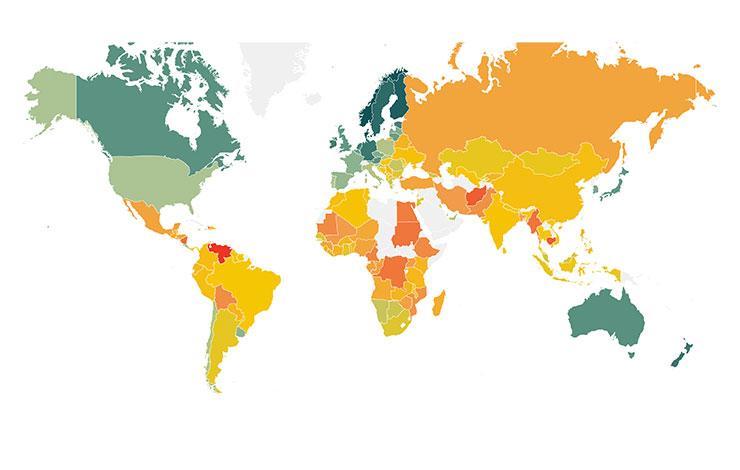

The Middle East and North Africa region is never far from the international trends headlines, but when it comes to some health issues, especially HIV and AIDS, it tends to take a back seat.
HIV and AIDS in the MENA region: a false sense of security
The general widespread impression is that HIV is the least problem to consider in an otherwise troubled part of the world. The reason behind that might be because the estimated infection rate among the general population is lower than 0.1% compared with 5% south of the Sahara.
But according to a new study from UNAIDS(1), HIV is thriving in the Middle East and North Africa. Infections have more than doubled since the beginning of the millennium, and AIDS-related deaths have almost tripled. Middle East and North Africa is today one of only two regions where HIV is still on the rise; in the rest of the world, infection rates and deaths from AIDS have either stabilized or are declining. The epidemic is now particularly concentrated in “key” populations, such as female sex workers, injecting drugs users, men-who-have-sex-with-men, prisoners, and migrants. A recent study in Tripoli, Libya(2) found that 87% of the participants who regularly use injected drugs are living with HIV. This could be the visible part of the iceberg, meaning that the virus is starting to spread beyond these most-at-risk groups. Women are increasingly being hit hard; nearly three-quarters of those living with HIV have been infected by their husbands, while small scale studies show that 10% of prisoners are living with HIV. In addition to a such gloomy picture, less than one in five people living with HIV are getting the medicines they need in the region, and the proportion of pregnant women receiving anti-retroviral therapy to prevent transmission to their children is less than half of that. Which is the lowest treatment rate in the world.
“If Stigma was a train, AIDS would be the last wagon”
Even if poverty, gender-based violence, and taboos around sex are among rooting causes that drive HIV across the Middle East and North Africa, stigma and discriminations constitute the most devastating ones.
The stigma exists at all levels: in some laws reinforced by selective religious teachings which criminalize same-sex relations, sex work, and injecting drug use. Despite the fact that most of MENA countries constitutions enshrine universal access to fundamental rights, a punitive approach through criminalization infringes not only upon the right to health, but also upon other fundamental human rights.
Stigma and discrimination motivate also government policies which implement coercive health approaches by imposing targeted coercion and compulsory health measures upon people under custody, forcing them into isolation or required HIV testing in most of MENA countries. On the other hand, it blocks the entry of migrant workers living with HIV into the country, or condones their expulsion, if found to be infected. 12 of the 41 countries which still impose restrictions on the entry, stay, or residence of people living with HIV are in the MENA region(3).
Not least, stigma exists also in individual behaviors. People living with HIV and those at risk face attitudes at home, in communities, in the work place, in their access to inheritance and in their children’s–or orphans-access to education, all of which make them feel like outcasts. They face, in some countries of the region, a widespread harassment, intimidation, exploitation and violence frequently perpetrated or condoned by those in positions of authority. This includes law enforcement officers who prevent the enforcement of existing laws that guarantee fundamental rights. The fear of police often deters them from reporting crimes against them and seriously impedes their access to health care, including HIV-related services, while discrimination is common among health workers.
According to the HIV Stigma Index, which tries to quantify this exclusion, more than half of people living with HIV in Egypt have been denied treatment in healthcare facilities and although health worker patterns may change, treatment is denied across the entire region. According to the same HIV Stigma Index, a fifth of those infecteded in Yemen have experienced physical harassment or assault and, in Sudan, a third have had to move or have been unable to find housing because of their HIV status.
Can laws save lives?
Together with non enforcement of some “friendly laws” due to individual behaviors of law enforcement officers, the implementation of criminalizing laws and coercive measures contribute to HIV vulnerability by driving whole groups underground, pushing them away from health care services and speeding the spread of HIV. To overcome such an awful situation, programs about empowering vulnerable groups and legal literacy campaigns promoting tolerance and addressing discrimination should be widely implemented among the general population, law enforcement personnel, and health care providers.
Although there have been plenty of high level political statements about the need to move forward in HIV response (NEPAD(4), Gulf Countries Counsel and, more recently, League of Arab States) only a few governments managed to step up. However, there are small, remarkable steps forward in the epidemic response: the emergence of NGOs for people living with HIV, like “El Hayet” in Algeria (the first ever in the region) “MENARosa” and “Women +”, two groups to support women living with HIV, for example*, or “Chahama”(5): a regional network gathering four hundred Muslim and Christians religious addressing stigma and discrimination. Also, legal services provided to people living with HIV in many countries with the support of IDLO especially in Tunisia, Egypt and Lebanon are making strides to support those who are HIV-positive, as is “MENAHRA”: a regional network implementing harm reduction programs all over the region for injecting drug users from Iran to Morocco. Finally, “ITPC MENA” is a regional network of advocates for treatment access(6).
Despite an already overwhelming situation for vulnerable groups and worrying warning signs for public health, HIV is unfortunately not a priority for most MENA governments and communities. This needs a holistic mobilization to fight stigma and to enable “good” laws, fully resourced and rigorously enforced, to widen access to prevention and care services for people living with HIV or most at risk, to improve their social support and to protect their human rights.
****
Citations






